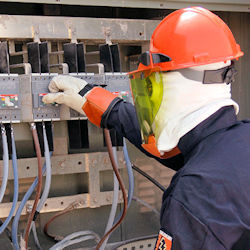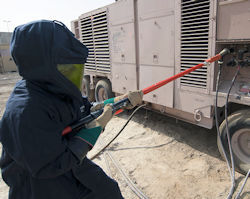Electrical Protective Equipment
Care and Use of Electrical Protective Equipment
Electrical Protective Equipment falls into two categories: Electrical PPE (PPE) and Insulating Protective Equipment (IPE).
Electrical (PPE): PPE refers to items typically worn by a worker to provide protection from recognized hazards. Depending on the job task to be performed, PPE for the electric power industry generally includes:
- Rubber insulating gloves and leather protectors to protect the hands and arms.
- Rubber insulating sleeves to protect the arms and shoulders.
- Flame-resistant (FR) clothing to protect the body against arc flash.
- Hoods to protect the head against arc flash.
- Hard hats to protect the head from electrical shorts, and striking or being struck by objects.
- Safety glasses and shields to protect the face against flying objects and arc flash.
- Safety shoes and overshoes to protect the feet and worker from being grounded.
Insulating Protective Equipment (IPE): Rubber and hardcover insulating protective equipment (IPE) is used to protect workers, such as those in aerial buckets, from contacting energized conductors. Unlike PPE, IPE is not worn on the body.
Insulating Protective Equipment (IPE) includes items such as:
- Insulating (rubber) line hose, blankets, and hoods.
- Insulating barriers made of fiberglass or phenolic resin.
- Live-line tools such as hotsticks, switchsticks, and shotgun sticks.
- Plastic or fiberglass line hoods and covers that can be installed with live-line tools.
All electrical protective equipment made of rubber should meet established safety standards and specifications.
Note: For more on this topic, see course 715 Electrical Safety for Technicians & Supervisors.
Knowledge Check Choose the best answer for the question.
6-1. How does insulating protective equipment (IPE) differ from personal protective equipment (PPE)?
You forgot to answer the question!


